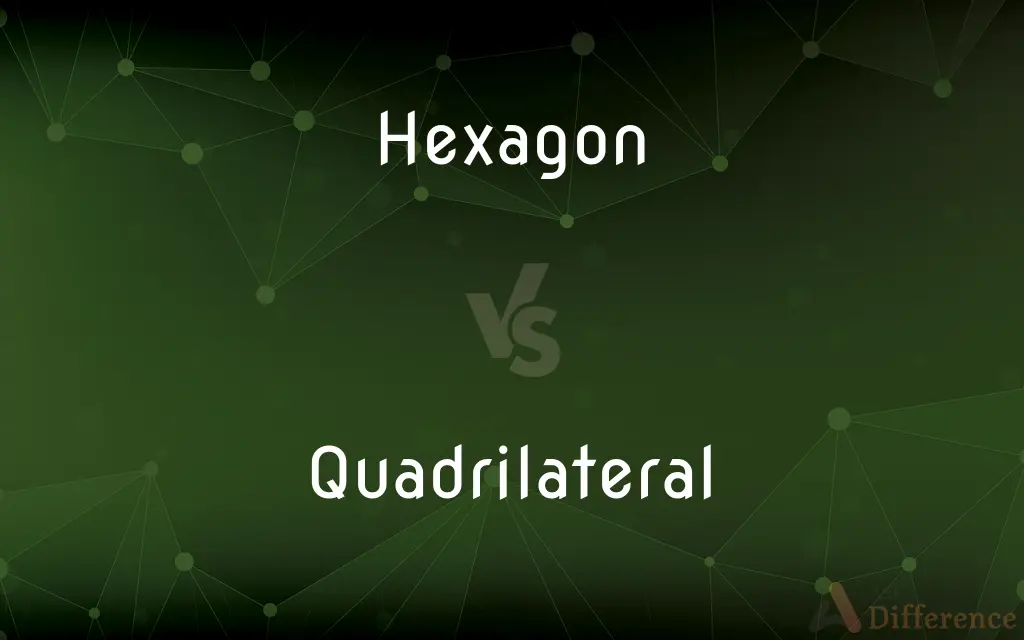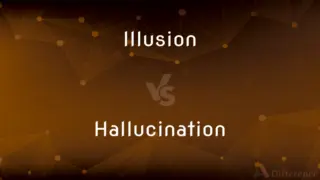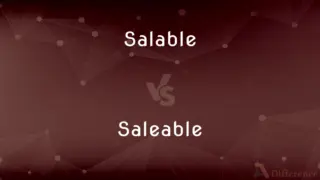Hexagon vs. Quadrilateral — What's the Difference?
By Tayyaba Rehman & Fiza Rafique — Updated on April 23, 2024
A hexagon is a six-sided polygon with various internal angle possibilities, while a quadrilateral consists of four sides and angles, offering different shape classifications.

Difference Between Hexagon and Quadrilateral
Table of Contents
ADVERTISEMENT
Key Differences
A hexagon is characterized by having six sides and six angles, which can be either regular or irregular depending on the equality of its sides and angles. Whereas, a quadrilateral has four sides and four angles, and it can be categorized into various specific types like squares, rectangles, or rhombuses based on side length and angle measurements.
The interior angles of a regular hexagon always sum up to 720 degrees, providing a uniform angle of 120 degrees each. On the other hand, the total of the interior angles in any quadrilateral is consistently 360 degrees, which can be unevenly distributed among the angles depending on the type of quadrilateral.
Hexagons often appear in natural formations and engineering designs due to their efficiency in covering large areas with minimal material. Quadrilaterals are more commonly used in everyday objects and architectural designs, reflecting a range of practical applications from building blocks to artistic elements.
In tessellations, hexagons are one of the few polygons that can tile a plane without leaving any gaps, which is a property not shared by all quadrilaterals. This makes hexagons particularly useful in areas like tiling and packing problems.
While both shapes are fundamental in geometry, the complexity of a hexagon with its six sides offers more geometrical intricacies compared to the relatively simpler and more commonly understood quadrilateral structure.
ADVERTISEMENT
Comparison Chart
Number of Sides
6
4
Interior Angle Sum
720 degrees
360 degrees
Regular Angle Measurement
120 degrees (if regular)
Varies, no fixed measure
Common Uses
Natural formations, tiling
Building, everyday objects
Tessellation Capability
Can tessellate without gaps
Depends on the type of shape
Compare with Definitions
Hexagon
Can be regular (all sides and angles equal) or irregular.
The logo features an irregular hexagon with varied angle sizes.
Quadrilateral
Includes squares, rectangles, rhombuses, and more.
The window was shaped like a perfect rectangle, a type of quadrilateral.
Hexagon
Used in geometry to explore tessellation and symmetry.
We explored hexagons in class to understand tessellation.
Quadrilateral
Studied for their properties and variations in geometry.
We studied various quadrilaterals and their properties in math.
Hexagon
Often seen in natural and synthetic structures for efficiency.
Hexagonal tiles are used for efficient floor tiling.
Quadrilateral
A four-sided polygon that can be simple or complex.
The child's drawing consisted of a simple quadrilateral.
Hexagon
Appears in various games and designs to add complexity.
The board game uses hexagons to create a dynamic playing field.
Quadrilateral
Found widely in architecture and design.
Quadrilaterals are fundamental in the design of modern buildings.
Hexagon
In geometry, a hexagon (from Greek ἕξ, hex, meaning "six", and γωνία, gonía, meaning "corner, angle") is a six-sided polygon or 6-gon. The total of the internal angles of any simple (non-self-intersecting) hexagon is 720°.
Quadrilateral
Used in art to create varied visual effects.
The artist used quadrilaterals to form an intriguing mosaic.
Hexagon
A plane figure with six straight sides and angles.
Quadrilateral
A quadrilateral is a polygon in Euclidean plane geometry with four edges (sides) and four vertices (corners). Other names for quadrilateral include quadrangle (in analogy to triangle) and tetragon (in analogy to, e.g., pentagon or hexagon).
Hexagon
A polygon with six sides and six angles.
Quadrilateral
A polygon having four sides.
Hexagon
(geometry) A polygon with six sides and six angles.
Quadrilateral
Having four sides.
Hexagon
A plane figure of six angles.
Quadrilateral
A polygon with four sides.
Hexagon
A six-sided polygon
Quadrilateral
An area defended by four fortresses supporting each other.
The Venetian quadrilateral comprised Mantua, Peschiera, Verona, and Legnano.
Quadrilateral
Having four sides.
Quadrilateral
Having four sides, and consequently four angles; quadrangular.
Quadrilateral
A plane figure having four sides, and consequently four angles; a quadrangular figure; any figure formed by four lines.
Quadrilateral
An area defended by four fortresses supporting each other; as, the Venetian quadrilateral, comprising Mantua, Peschiera, Verona, and Legnano.
Quadrilateral
A four-sided polygon
Quadrilateral
Having four sides
Common Curiosities
What defines a hexagon?
A hexagon is defined by having six sides and six angles.
Are all hexagons symmetrical?
Not all; only regular hexagons are symmetrical.
What is the sum of the interior angles of a hexagon?
The sum of the interior angles of a hexagon is 720 degrees.
Can a quadrilateral have curved sides?
No, by definition, a quadrilateral has straight sides.
What types of quadrilaterals are there?
Types include squares, rectangles, trapezoids, and rhombuses.
What is an example of a hexagon in real life?
Honeycombs in beehives are real-life examples of hexagons.
Which is more common in nature, hexagons or quadrilaterals?
Hexagons are more commonly found in natural formations.
Do all quadrilaterals tile a plane?
No, not all quadrilaterals can tile a plane without gaps.
Can a quadrilateral be both a rectangle and a rhombus?
Yes, such a shape is specifically known as a square.
How many sides does a quadrilateral have?
A quadrilateral has four sides.
How do quadrilaterals help in building construction?
They provide a basic shape that is structurally sound and versatile.
Can the sides of a quadrilateral be of unequal length?
Yes, the sides of a quadrilateral can vary in length, except in shapes like squares.
How does a hexagon differ from a quadrilateral in tessellation?
Hexagons can tessellate without gaps, unlike most quadrilaterals.
Are hexagons more efficient than quadrilaterals?
Yes, hexagons cover more area with less perimeter, which can be more material-efficient.
What geometric properties are unique to hexagons?
Hexagons have a unique ability to tessellate and efficiently partition space.
Share Your Discovery

Previous Comparison
Illusion vs. Hallucination
Next Comparison
Salable vs. SaleableAuthor Spotlight
Written by
Tayyaba RehmanTayyaba Rehman is a distinguished writer, currently serving as a primary contributor to askdifference.com. As a researcher in semantics and etymology, Tayyaba's passion for the complexity of languages and their distinctions has found a perfect home on the platform. Tayyaba delves into the intricacies of language, distinguishing between commonly confused words and phrases, thereby providing clarity for readers worldwide.
Co-written by
Fiza RafiqueFiza Rafique is a skilled content writer at AskDifference.com, where she meticulously refines and enhances written pieces. Drawing from her vast editorial expertise, Fiza ensures clarity, accuracy, and precision in every article. Passionate about language, she continually seeks to elevate the quality of content for readers worldwide.













































